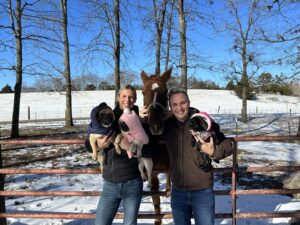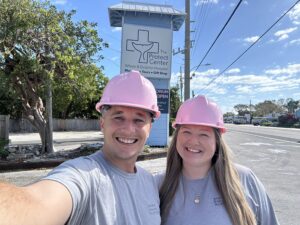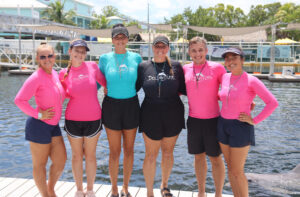Hunter Kinney, head coach and chief innovation officer for Dolphin Life Inc. in the Upper Keys, is a Kentucky boy who loves all animals.
Growing up on a 3-acre farm in Somerset, Kentucky, Kinney was surrounded by a menagerie of landlocked farm animals: horses, goats, dogs and cats, and free-flying wild birds such as hawks, vultures and eagles.
Kinney saw his first dolphins around the age of 6 while on a Central Florida family vacation at Seaworld Orlando.

Hunter Kinney (r) and husband Luke (l) in Kentucky with their three pet pugs: Buoy, Harbor and Whaler. Credit: Hunter Kinney, Dolphin Life Inc.
“I was just mesmerized. Seeing the trainers and dolphins interact together is what made me fall in love with dolphins,” Kinney recalls. “I had to chase my dolphin dream.”
Kinney graduated from Eastern Kentucky University with a degree in animal studies and came to the Keys 10 years ago as an intern with Dolphins Plus Oceanside in Key Largo.
Dolphins Plus Marine Mammal Responder (DPMMR) was founded by Art and Nancy Cooper, who initially rebranded Dolphins Plus Oceanside to DPMMR; and again in 2025 to Dolphin Life Inc.
Art is head life guard (or founder and director of strandings) and Nancy is president. For nearly 40 years, DPMMR’s team, led by the Coopers, has responded to beached, sick and injured dolphins and whales in the Keys.
The Dolphin Life facility in Key Largo enables visitors to swim with healthy dolphins.
And with the rebranded Dolphin Life Hospital (formerly The Protect Center) in Islamorada, long-term facilities are soon to perform life-saving rehabilitation and care for large stranded or sick dolphins and whales. Federal approvals are expected to be finalized in December.

Hunter Kinney (l) with Amanda Daniels (r), Dolphin Life’s chief momentum officer and a good friend. The two worked to develop Dolphin Life’s Explorashorium Marinelife Museum at Dolphin Life in Islamorada. Credit: Dolphin Life Inc.
At Dolphin Life Hospital, visitors can tour its treatment and educational museum facilities. Daily backlot rescue tours, daily at 11 a.m. and 2:30 p.m., feature a behind-the-scenes tour of the working hospital.
The facility includes a 40-foot-diameter pool, to open in October for long-term mammal rehabilitation.
Its Explorashorium is a 2,000-square-foot interactive museum-style space with aquariums, touch tanks and immersive rotating exhibits; and an educational classroom-style space for meetings, small groups, events and seminars.
The Dolphin Life gift shop features sustainable refillery items and newly branded Dolphin Life clothing, merchandise, gifts and souvenirs. Sales of branded merchandise — “similar to the Salt Life brand” — are brisk, Kinney said.
Besides new merchandising, the rebranding of Dolphin Life. led by Kinney, includes new signage, logo and immersive programs. A new Experience the Dolphin Life in Key Largo half-day experience includes a tour, swimming and snorkeling with dolphins, a hands-on dolphin care activity with behind-the-scenes care tasks, and photos and a T-shirt.
The Keys’ two major dolphin care organizations, Dolphin Life Inc. in the Upper Keys and Dolphin Research Center in the Middle Keys, have different missions.

Hunter Kinney (second from r) and his team of Dolphin Life coaches, attired in new Dolphin Life rash guards. (l to r): Danika Smith, Maddie Jackson, Jenna Haberle, Kayla Lucero, Kinney and Cristina Cuhel. Credit: Dolphin Life Inc.
The 41-year-old Dolphin Research Center on Grassy Key was established in 1984 to provide a nonprofit sanctuary, research facility and forever home to dolphins and California sea lions. DRC’s research program focuses on three main areas: cognition, behavior and husbandry.
“Monroe County is home to more mammal facilities than any county in America,” said Rita Irwin, president and chief executive officer of Dolphin Research Center in Marathon. “We look forward to continuing our mutually supportive relationship with the Dolphin Life team.”
Dolphin Life’s mission — to be South Florida’s only working and teaching veterinary hospital treating injured bottlenose dolphins, whales and other marine mammals — is to provide protection and care of rescued and stranded dolphins and whales and to provide forever homes for non-releasable dolphins in the Keys.
Judy Hull, the Islamorada Chamber of Commerce’s executive director, was instrumental in persuading Kinney, who’s in his early 30s, to become involved with Keys tourism as a volunteer DAC IV member.
“Hunter is an inspiring steward of our wild sea life. Through his leadership at Dolphin Life, the first hospital and welcome center of its kind in South Florida, he’s not only saving dolphins and whales, he’s also educating the next generation about the importance of protecting them,” said Judy Hull, executive director, the Islamorada Chamber of Commerce.
“Hunter brings incredible passion and energy to protecting marine life. From hands-on care to community outreach, he’s making a real difference for dolphins, whales, and for future generations,” Hull said.
Kinney lives in Islamorada with husband Luke, who directs Key Largo’s Island Dolphin Care. Dolphin Care’s mission is to provide unique, dolphin motivational, and educational programs to children, adults with special needs, their families and caregivers.
Keys Traveler: When did you first come to the Florida Keys and why?
Hunter Kinney: In fall 2015 to participate in a dolphin training internship. I knew I wanted to work with dolphins for a career, but didn’t have my eyes set on doing so in the Florida Keys until I was offered a full-time position here and decided to stay.
KT: What aspects of the Keys environment or way of life matter most to you?
HK: I absolutely love how unique the Florida Keys are — both in terms of our environment and our Keys lifestyle. I came from Kentucky and I do not like cold weather, so the sunshine and warm weather throughout the entire year is so uplifting and energizing. The islands are also so cut off from ‘city life’ — I feel like I’m living in paradise, surrounded by beautiful blue water and incredible wildlife. I see dolphins every day at work, but I’m still mesmerized seeing them play out in the wild anytime I encounter them on the boat. The community here is also so special, connected, and dedicated to protecting our community and culture. (It also has no shortage of character and fun.)
KT: What inspired you to become passionate about protecting the Keys’ natural world and how does that passion impact your daily life and work?
HK: I have always loved animals and wildlife. I grew up around every farm animal you could think of, and as soon as I was old enough started to volunteer at a wildlife rehabilitation clinic back home. Working with animals and wildlife has been a part of my life for my entire life. But dolphins have always had a special place in my heart, so I moved to the Keys to be able to work with them. Shortly after starting, a group of dolphins beached themselves and our team responded to them. I realized there was a bridge between the wildlife rehabilitation and non-profit work I did back home and the dolphin world. This translated into my passion for protecting the whales and dolphins here in the Florida Keys and shapes everything I do at work.
KT: How do you personally work to ‘connect and protect’ the Keys’ environment and the island chain’s unique lifestyle?
HK: I think I have it easy — because everybody loves dolphins and they are so easy to connect to. My work revolves around bringing people in and building a connection between themselves and our dolphins and our story of marine mammal rescue. When someone gets in the water with a dolphin and starts to play with them and sees how we care for them, they can’t help but build a connection to a living being. Pair that new connection to a dolphin with actionable ways to protect dolphins in the wild — and suddenly there is a new wildlife warrior helping to protect dolphins which, in turn, protects the environment as a whole. Beyond this, my job is to be a storyteller — sharing the stories that people will connect with. We focus on storytelling and getting the “story” right. When the story is right, it makes people feel, and those feelings lead to action.
KT: What do you hope your environmental actions in the Keys will help to accomplish?
HK: My main hope is that the wildlife in our backyard — from the largest (dolphins and whales) to the smallest (corals) — have a safe home here in the Florida Keys forever. But secondary to that, I hope our wildlife have the support they need when they need it.
For me personally, that looks like making sure the dolphins and whales have a rescue team, a hospital, and a second chance at life in our local waters. On the rare occasion that release isn’t an option, it’s important that our dolphins have a loving, forever home to live out a good life. I hope that our actions, programs, and experiences are all tools that help us advocate for a better future for dolphins and whales worldwide.

